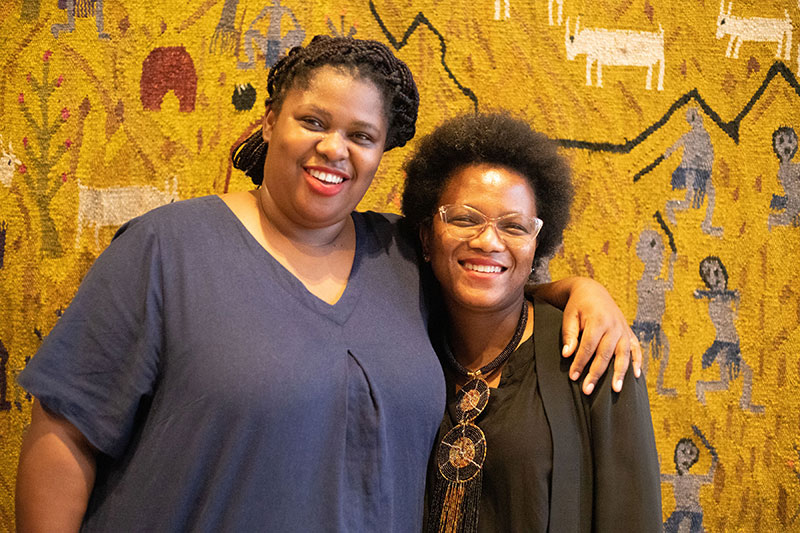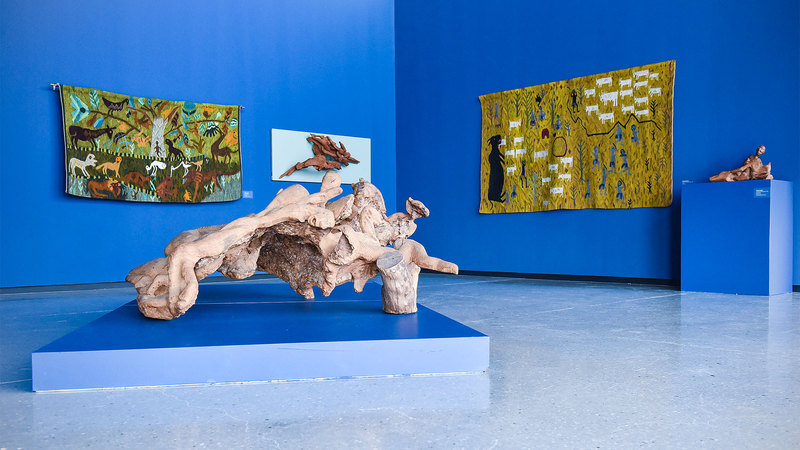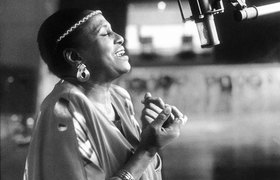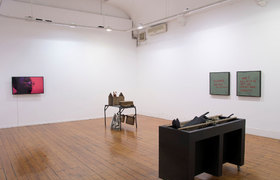Heritage Month: ‘I want to call out their names one by one’
23 September 2022 | Story Helen Swingler. Photos Lerato Maduna. Director Roxanne Harris. Videography & Video Edit Carbon Visuals. Read time 10 min.“I want to call out their names one by one, as a way in which we don’t forget them,” art curator Nontobeko Ntombela said of the 45 black women artists exhibited at the Norval Foundation gallery. Co-curated by Ntombela and Dr Portia Malatjie, it is a milestone exhibition of a largely excluded heritage. Some have never been exhibited, their stories never told, never written.
It is a unique heritage, said Ntombela of the showcase of 200 works in the year-long exhibition, titled When Rain Clouds Gather: Black South African Women Artists, 1940–2000.
“This is what they have left us by way of legacy.”
While the co-curators are reluctant to claim any firsts, the exhibition is unique in its range and creative horizon and as a mirror of South African black women creatives.
“Both of us have been looking at art history practices in parallel for over a decade,” said Ntombela. “And then it became pertinent to realise this together, collaboratively, because it’s also valuable to have multiple voices at the forefront of curating and telling these histories.”
A Johannesburg-based curator, Ntombela is a lecturer in the History of Art Department at the University of the Witwatersrand’s (Wits) School of Art. She is also a doctoral candidate at the University of Cape Town (UCT) studying towards a PhD in art history.

Dr Malatjie is a senior lecturer in visual cultures at UCT’s Michaelis School of Fine Art and co-curator of the UCT Works of Art Collection. She is adjunct curator of Africa and African Diaspora at the Hyundai Tate Research Centre: Transnational at Tate Modern (London).
Under-appreciated heritage
The exhibition reflects a rich but under-appreciated heritage; an extraordinary collection of cross-generational work spanning six decades – from the rise of early modernism to the contemporary period. It includes paintings, drawings, etchings, printmaking, photography, sculptures, ceramics, installations and textiles.
Black women are the most marginalised of the country’s artists, their early work and contributions blurred particularly by the cultural, social and gendered notions of art versus craft; ‘women’s work’ linked to the production of ceramics, textiles, and beadwork, said Ntombela.
“The lack of access to certain artists is because most of their work remains in the hands of the private owners.”
But bringing it all together took three years.
“The lack of access to certain artists is because most of their work remains in the hands of the private owners whose contact details are not easily traceable – or in public collections that don’t have suitable mechanisms in place to make these works easily accessible,” said Ntombela.
Some artists* such as Esther Mahlangu are well recognised, while others such as Desiree Kok and Bongi Kasiki are not.
It is a heritage and political milestone that must be celebrated, said Ntombela.
“There’s never been a moment where we see such a collection of works together. Also, the exhibition does something; it gives you a body of works, a conglomerate of artwork coming together in a big cluster. And suddenly you have an encyclopedia, a book that has never been written on black women artists.
“Certainly, it was a surprise to us that so many black women artists exist, even though we had seen the names coming up in our research. And once the exhibition came together, it hit us in ways that we never imagined.”
The co-curators’ intention was also to highlight the lesser-known names.
“And that is also a political gesture on our part and part of the celebration,” said Ntombela. “I want to call out the names one by one as a way in which we don't forget them.”
Teaching and learning moment
The exhibition has also been valuable to teaching and learning in art history. Ntombela brought her Wits postgraduate students in art history to see the exhibition, which is central to her Writing Art Histories course. The students choose an artist and one of their artworks for their biographical projects.
There is little research on the practices of women artists from 1940 to 1960 because there is a belief that they only really made their mark in the 1960s, said Ntombela.
“This is false, given Valerie Desmore’s contribution in the 1940s from the age of 16. And so, 1940 signifies this beginning moment.”
She wants her students to produce more than a chronology of the artists’ lives. The aim is to fill in gaps in South Africa’s disparate art archive.
“Historical writing has focused on biographies in ways that overshadow the technical, the conceptual and the intellectual contributions these artists have made through the work.”
Bringing this range of work and artists together in this way has been “very pertinent” said Malatjie, a glimpse of the vastness of work produced by black women, particularly black women modernists.
The gathering challenge
That the exhibition takes the name of African author Bessie Head’s first novel, When Rain Clouds Gather, is also significant. One of Africa’s best-known women writers in English, Head lived as an apartheid outcast in exile in Botswana. The title’s symbolism is rich; a harbinger of change and disruption Ntombela and Malatjie hope to usher in through the exhibition.
There were four main reasons for using this title.
“First, we wanted to highlight how black creative practices and their representation don’t always sit under one discipline; writers and artists have long worked across different disciplines,” said Ntombela.
“It shows how black women creatives have always illustrated powerful stories of hardship, tragedy and hope.”
“Second, it shows how black women creatives have always illustrated powerful stories of hardship, tragedy and hope in ways that tell us about how women have navigated their worlds. And as such, we see Head’s book in the same way we see the artworks as the space for critical theorisation where, through fiction and art, black women tell us about the intersection of their critique and observation of life happening around them – and the place of imagination.”
Third was the title’s metaphoric reference to clouds and what might happen when these “gather”.
“It was another point we wanted to make. What would happen if black women artists’ work were exhibited in one place? What canon shift does it offer us?”
And like any encyclopaedia, the art canon is always being revised, said Ntombela.
“When we see these efforts together in the same room, we see so much more … it is as if we have always been given one page at a time. And suddenly, you have 200 pages at a time, and you see that a different history is being written.”
The exhibition is a reminder of the country’s black women artists and their struggles for us to have a voice today, said Ntombela. This extends to the art classroom.
Malatjie added: “This is us trying to write them in history or trying to extend the writing. It is also an acknowledgement of the contribution that they have made to art history and acknowledging them as practitioners, as theorists, as people who were thinking critically.
“It is also acknowledging the specific practices and what they contributed. And it’s not only celebrating what they made and celebrating them, but it is a celebration for us, because we are able to experience this history for the first time [at the exhibition] in 2022.
“So, it is a very much like a communal celebration of acknowledging the history that is out there that belongs to us, that these women have gifted us in a way that is very meaningful. And very caring.”
The gaps in the history between 1940 and 2000 are reflected in the exhibition design, said Ntombela.
“As you walk through, the first thing that you will see is the map, and the chronology of years that articulates the different moments of history and what’s important … We wanted to start with a place where there’s no resolution; there are questions, gaps and absences.”
For the co-curators, the exhibition is a celebration of what blackness is in its diversity and complexity, said Malatjie.
“And this exhibition is not for us. It is for everyone. But first, it is for people of colour … to see themselves illustrated in visuality. And we hope that people will come back and say, ‘It's a gift to us’.”
The exhibition runs until 9 January 2023.
*Among the featured artists are Selina Baloyi, Bongi Bengu, Edith Bukani, Rose Buthelezi, Dudu Cele, Desiree Kok, Valerie Desmore, Bongiwe Dhlomo, Patience Dlamini, Faiza Galdhari, Josephine Ghesa, Bina Gumede, Francis Halala, Lallitha Jawahilirar, Bongi Kasiki, Noria Mabasa, Diana Mabunda, Rosinah Maepa, Rebecca Mafu, Esther Mahlangu, Philda Majozi, Venus Makhubele, Esther Maswanganyi, Sisanda Mbana, Elizabeth Mbatha, Katherine Mchunu, Gladys Mgudlandlu, Judith Mkhabela, Dinah Molefe, Ruth Motau, Nombeko Mpako, Sanna Naidoo, Allina Ndebele, Henriette Ngako, Rita Ngcobo, Gabisile Nkosi, Bonnie Ntshantshali, Sophie Peters, Helen Sebidi, Eunice Sefako, Alvitha Sooful, Kedibone Sarah Tabane and Elise Xaba.
 This work is licensed under a Creative Commons Attribution-NoDerivatives 4.0 International License.
This work is licensed under a Creative Commons Attribution-NoDerivatives 4.0 International License.
Please view the republishing articles page for more information.
















